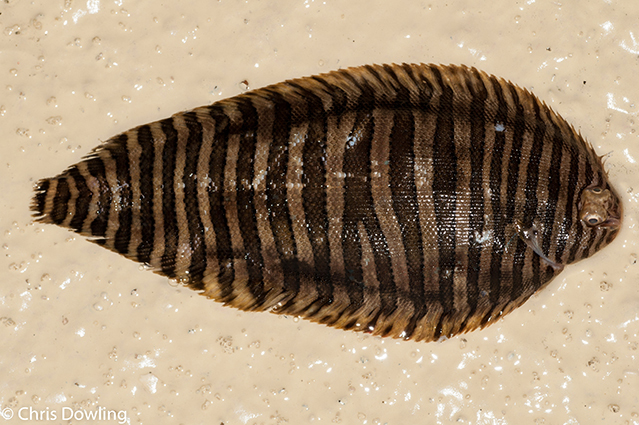Wicker-work Sole, Zebrias craticula (McCulloch 1916)
Other Names: Wicker Work Sole, Zebra Sole

A Wicker-work Sole, Zebrias craticula, from Western Australia. Source: Chris Dowling / FishBase. License: All rights reserved
Summary:
Head and body with more than 20 numerous dark brown transverse bands with narrow blackish dotted margins, the bands about as wide as the pale interspaces, and often a narrow indistinct band running through the interspaces. The bands continue onto the fins, including across the caudal fin.
Cite this page as:
Bray, D.J. 2024, Zebrias craticula in Fishes of Australia, accessed 06 Jul 2025, https://fishesofaustralia.net.au/home/species/2183
Wicker-work Sole, Zebrias craticula (McCulloch 1916)
More Info
|
Distribution |
Endemic to northern Australia, from the Houtman Abrolhos islands, Western Australia, around the tropical north to east of Elliot Heads, Queensland. Inhabits soft sediment areas in nearshore coastal and continental shelf waters. |
|
Fisheries |
May be taken as bycatch in commercial prawn trawl fisheries. |
|
Etymology |
The specific name is from the Latin craticula (= grill, grating) in reference to the "20-24 dark cross-bands" on the head, body and fins. |
|
Species Citation |
Synaptura craticula McCulloch 1916, Mem. Qld Mus. 5: 62, pl.9 (fig.1). Type locality: near Bowen, Queensland. |
|
Author |
Bray, D.J. 2024 |
|
Resources |
Wicker-work Sole, Zebrias craticula (McCulloch 1916)
References
Allen, G.R. 1997. Marine Fishes of Tropical Australia and South-east Asia. Perth : Western Australian Museum 292 pp. 106 pls.
Allen, G.R. & Swainston, R. 1988. The Marine Fishes of North-Western Australia. A field guide for anglers and divers. Perth, WA : Western Australian Museum vi 201 pp., 70 pls.
Gloerfelt-Tarp, T. & Kailola, P.J. 1984. Trawled Fishes of Southern Indonesia and Northwest Australia. Jakarta : Dir. Gen. Fish. (Indonesia), German Tech. Coop., Aust. Dev. Ass. Bur. 406 pp.
Larson, H.K., Williams, R.S. & Hammer, M.P. 2013. An annotated checklist of the fishes of the Northern Territory, Australia. Zootaxa 3696(1): 1-293
Marshall, T.C. 1964. Fishes of the Great Barrier Reef and Coastal Waters of Queensland. Sydney : Angus & Robertson 566 pp. 136 pls.
McCulloch, A.R. 1916. Ichthyological items. Memoirs of the Queensland Museum 5: 58-69 figs 1-4 pls 7-9 See ref at BHL
Munroe, T.A. 2001. Soleidae, Cynoglossidae. pp. 3878-3901 in Carpenter, K.E. & Niem, T.H. (eds). The Living Marine Resources of the Western Central Pacific. FAO Species Identification Guide for Fisheries Purposes. Rome : FAO Vol. 6 pp. 3381-4218.
Munroe, T.A. 2021. Zebrias craticulus. The IUCN Red List of Threatened Species 2021: e.T158881036A158881684. https://dx.doi.org/10.2305/IUCN.UK.2021-2.RLTS.T158881036A158881684.en. Accessed on 06 March 2024.
Norman, J.R. 1926. A report on the flatfishes (Heterosomata) collected by the F.I.S. Endeavour, with a synopsis of the flatfishes of Australia and a revision of the subfamily Rhombosoleinae. Biological Results of the Fishing Experiments carried on by the F.I.S. Endeavour 1909-1914 5(5): 219-308 figs 1-15 (as Brachirus craticulus)
Sainsbury, K.J., Kailola, P.J. & Leyland, G.G. 1984. Continental Shelf Fishes of Northern and North-Western Australia. Canberra : Fisheries Information Service 375 pp. figs & pls.
Whitley, G.P. 1964. A survey of Australian Ichthyology. Proceedings of the Linnean Society of New South Wales 89(1): 11-127 (as Strabozebrias craticulus)



